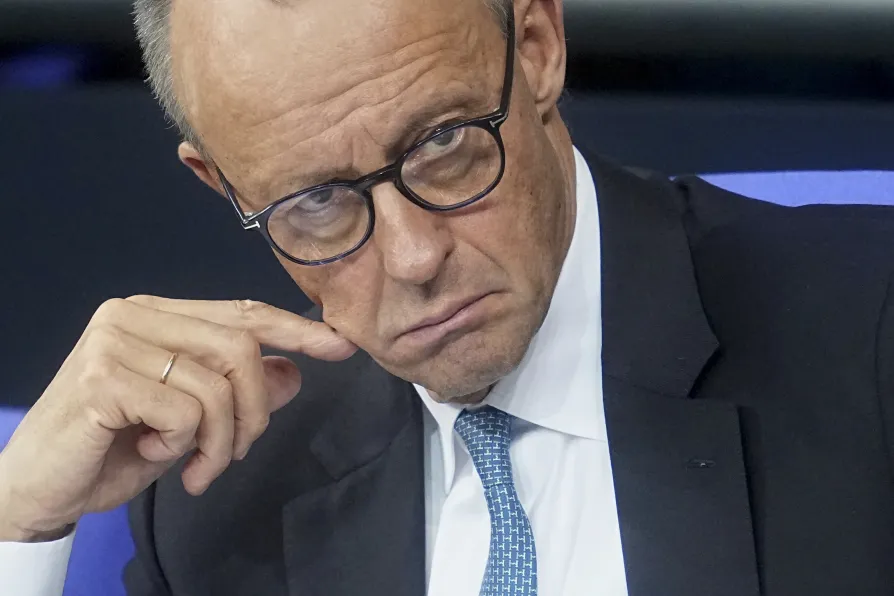FRAN HEATHCOTE believes that while the the Chancellor outlined some positive steps, the government does not appreciate the scale of the cost-of-living crisis affecting working-class people, whose lives are blighted by endemic low pay
German Chancellor Friedrich Merz is pouring €11.5bn into the Kiev swamp, blocking Trump’s peace plan, and pushing Nato right up to Russia’s borders – no matter if it costs hundreds of thousands of lives, warns SEVIM DAGDELEN

 German Chancellor Friedrich Merz attends the general debate on the budget in the Bundestag, in Berlin, November 26, 2025. Photo: Michael Kappeler/dpa via AP
German Chancellor Friedrich Merz attends the general debate on the budget in the Bundestag, in Berlin, November 26, 2025. Photo: Michael Kappeler/dpa via AP
DURING the budget deliberations in the German Bundestag on November 26, Chancellor Friedrich Merz boasted that he wants to send another €11.5 billion to Ukraine.
While every euro for pensions is haggled over, this federal government keeps making ever more money available to prolong the war.
Chancellor Merz is not deterred either by the gold toilets in Kiev or by the ethnic nationalism of the Kiev regime. Ukraine is supposed to fight Nato’s proxy war against Russia. And this proxy war must absolutely continue.
Just as British prime minister Boris Johnson once stopped the Istanbul talks in 2022, today it is German Chancellor Merz who, together with his European colleagues, has turned US President Donald Trump’s peace plan into a war plan.
Nato’s eastward expansion continues
For in the plan, altered at the insistence of the Europeans and Ukraine, the question of Ukraine’s future Nato membership is no longer addressed. Yet that is the crucial difference.
The Nato eastward expansion — which, contrary to all Western promises after the end of the cold war, has significantly contributed to the escalation — is to be allowed to continue; that is the position of the German government and the Europeans.
This makes it clear that Berlin has no interest whatsoever in freezing the conflict. The war is being prolonged in the bloody illusion that Russia can still be ruined.
At the same time, the scenario of a Russian attack on Nato in 2029 is being conjured up, apparently to justify preventive strikes against Russia and the continuation of the war in Ukraine — especially Germany’s own high resource commitment.
From the domino theory to World War III?
In the Vietnam war, it was the domino theory that was used to justify US military intervention. To prevent the spread of communist ideology to neighbouring countries, Washington claimed, more than a million Vietnamese were murdered by the US.
Today, the German government has committed itself to the domino theory. Involvement in the war in Ukraine must be stepped up to prevent it spilling over into Nato countries. In doing so, they are playing with the prospect of a third world war by continuing to hold out the prospect of Nato membership to Ukraine.
Simple minds buy the narrative that Trump is the Europeans’ counter-figure, the “peace president.” The truth, however, is that it was the US administration itself which, under pressure from Kiev and the Europeans, rewrote its own peace plan into a war plan and believed it could simply bracket the Nato issue.
Things that Washington would never tolerate on its own borders continue to be forced upon Russia. A rejection of realistic foreign policy. Anyone who is not prepared to discuss the Nato question is betting solely on continuing the war, in which hundreds of thousands more will have to die. Successful diplomacy, however, is rarely compatible with double standards.
Sevim Dagdelen is a former member of the Bundestag.

The cancelled China trip of the German Foreign Minister marks a break with Helmut Schmidt’s China policy and drives Germany further into Washington’s confrontation course, warns SEVIM DAGDELEN

In Washington, the willingness to accept an open war with Russia is growing — at Europe’s expense. While Nato states are being drawn into confrontation, Europe risks becoming the battlefield of a potential world war, warns SEVIM DAGDELEN

In a speech to the 12th Xiangshan Forum in Beijing, SEVIM DAGDELEN warns of a growing historical revisionism to whitewash Germany and Japan’s role in WWII as part of a return to a cold war strategy from the West — but multipolarity will win out

In the first half of a two-part article, PETER MERTENS looks at how Nato’s €800 billion ‘Readiness 2030’ plan serves Washington’s pivot to the Pacific, forcing Europeans to dismantle social security and slash pensions to fund it










